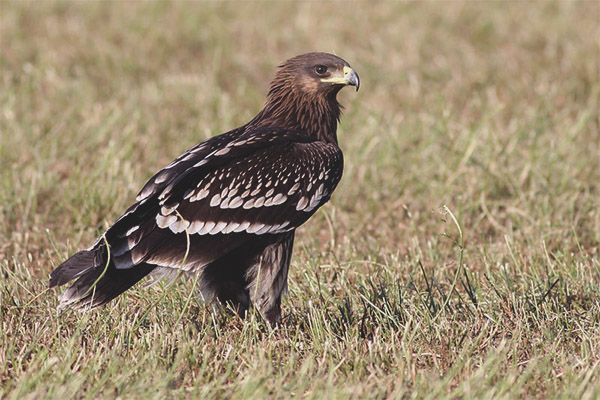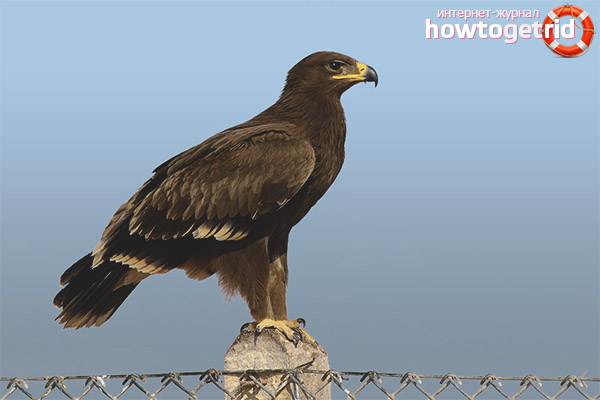The content of the article
Today we will consider another representative from the family of hawks, namely the spotted eagle large. The bird leads a hidden lifestyle, and therefore it is not possible to study it thoroughly. However, there is information regarding distribution, nutrition, reproduction and general characteristics of the breed group. Otherwise, spotted eagles are called hermit, because they prefer to stay alone, and also do not like to be near a person.
Habitat and description
- Birds of the family under discussion are medium-sized. However, some scientists attribute them to individuals, famous for their large size. Again, it all depends on who to compare. Thus, the spotted eagle-length grows to 75 cm., The body weight of the individual varies in the range of 1.5-3 kg.
- Sexual dimorphism appears clearly, females are larger than individuals of male sex.There is also a lesser spotted eagle, its big brother is larger, as can be understood from the name. But if you meet the birds in the field, then they can easily be confused. Only an experienced eye can determine the category.
- By color, feathers are monotonously colored. They are brown, dark. However, the area under the tail, the occipital part, the chest is light. Blackish or brownish feathers appear on them. It is extremely rare to find birds that are also yellowish or ocher on the background of a brown hue.
- In young plumage is light, there are specks in the form of droplets in the upper section of the body. You can also find individuals whose main shade is sandy yellow or ocher. The color of the claws and beak have a black tone, the area of the nostrils and the paws themselves are yellowish. On their feet feathers stretch down to the hands.
- As for distribution, these birds can be found in cool parts of Europe, be it Poland or Finland. They also live in Mongolia, Hungary, Pakistan, China. In the vastness of our homeland spotted eagles were noticed in the Kaliningrad region and up to Primorye.
- For wintering birds are collected and forwarded to Indochina, India, Iran.Since individuals belong to predators, they are found in meadow-steppes, in marshland, near rivers, reservoirs and lakes. It is in this area that the spotted eye looks out and pounds its prey.
- Birds prefer to live on flat or high terrain. They often live in the mountains, the height of which extends for 1 km. upwards. As for hunting, individuals prefer to look for food on the ground or to wait for its arrival, watching from the air. The diet consists of rodents of different families, as well as small birds or reptiles.
- Spotted eagles build nests for future offspring in tall trees. In this case, after construction, this dwelling will be used from year to year. The laying is carried out at the end of spring, usually the expectant mother gives up to 3 eggs. But in most cases there are two.
- After the female has laid the first egg, she immediately starts to incubate, but does not wait for the second one to appear. Partly for this reason, chicks are born at intervals, but the last chick usually dies because of rivalry with the first.
- When a generation grows up to 2 months, it can stand on the wing. These individuals quickly grow and learn, soon they, together with their father and mother, go to the place for wintering. Spotted eagle large is protected as an endangered and rare species.
Lifestyle
- Representatives of the family are monogamous, in order to achieve a mature sexual age they wait 4 years. Some individuals mature earlier, then they can reproduce at the age of 3 years.
- Build a home for future offspring together. Then they arrive every year for laying and hatching eggs. Since breeding is fast enough, soon parents will fly back to warm regions with chicks.
- By their natural characteristics of birds can be attributed to cannibals. That is, when the female laid her eggs, they hatched with a certain gap, then a struggle begins between the chicks. The elder simply eats the younger.
- If the laying is carried out in May, then in the fall the family of birds with their own replenishment may be sent to winter. Africa, Europe, and Asia are chosen as warm lands.
Interesting Facts
- It is worth noting that the individuals in question have a rather extensive habitat. If you look at it from the other side, the interesting fact is that the represented birds have no subspecies.
- Numerous studies have confirmed the fact that individuals of two close species may well interbreed with each other (small and large spotted eagle). The result is quite viable hybrids.
- Unfortunately, this species is shrinking around the world. Therefore, birds are listed in the Red Book. Such individuals rapidly disappear in their habitat. In the territory of the Russian Federation, the Far Eastern and European populations are protected.
- Such individuals are under close guard. Due to widespread deforestation, the number of species is reduced. The problem is that such birds nest on the crowns of tall trees. People are constantly concerned about the habitat of wild animals and birds.
- Birds are monogamous and build a nest on their own. They can also occupy old vacant nests. Such individuals mask their home very well. They close it with fir and aspen branches.
- In the mating season in early spring, such individuals make very interesting sounds. Considered birds due to such cries can be heard at a distance of 3.5 km. In common people, it is precisely for this reason that the individuals in question are called "screamers".
Spotted eagles are unique individuals of their kind. Unfortunately, they do not have subspecies. Their population is sharply reduced due to human activity. Eagles are listed in the Red Book.The number of birds is very small, even despite the extensive habitat.
Video: Great Spotted Eagle (Aquila clanga)












To send